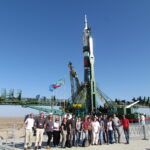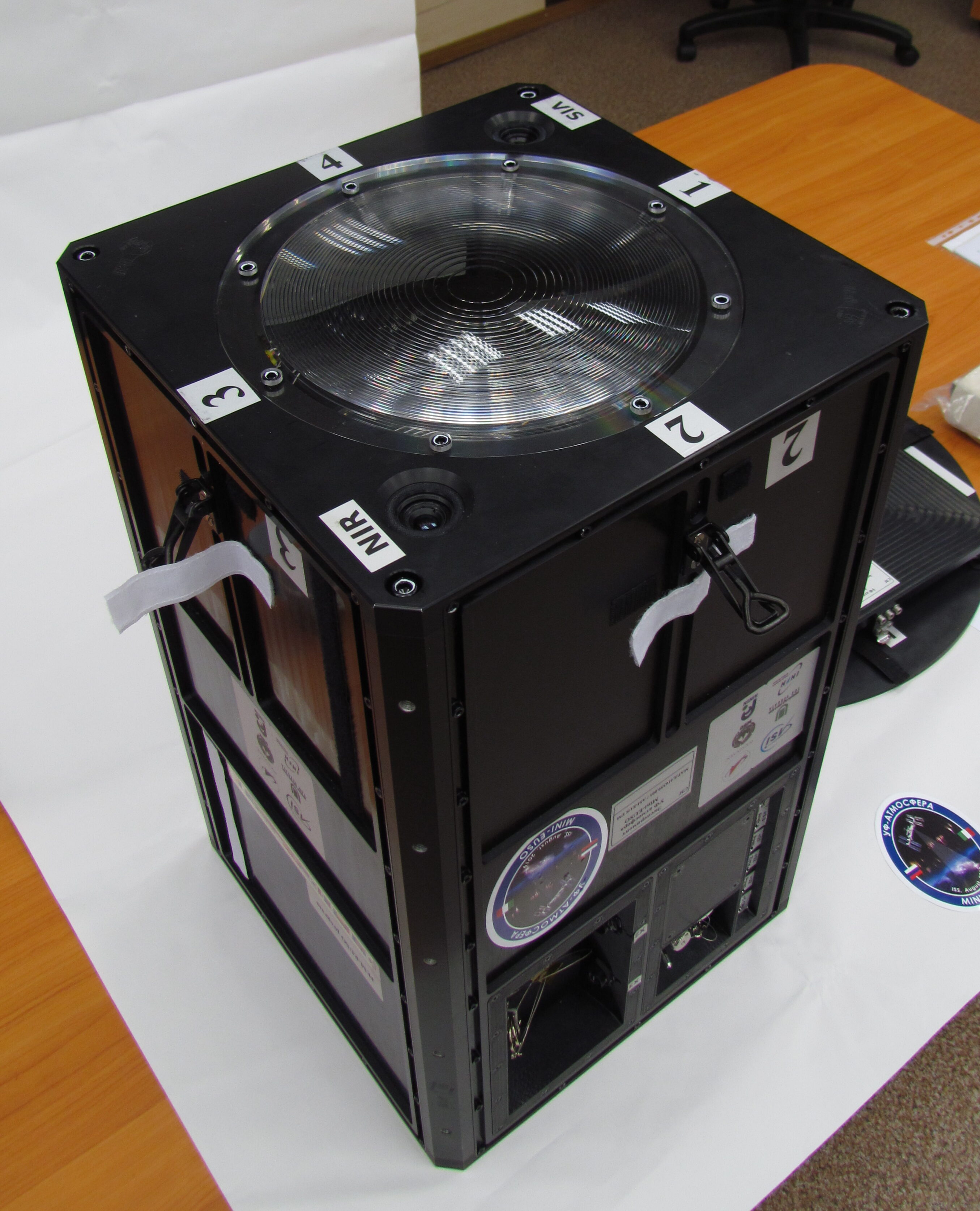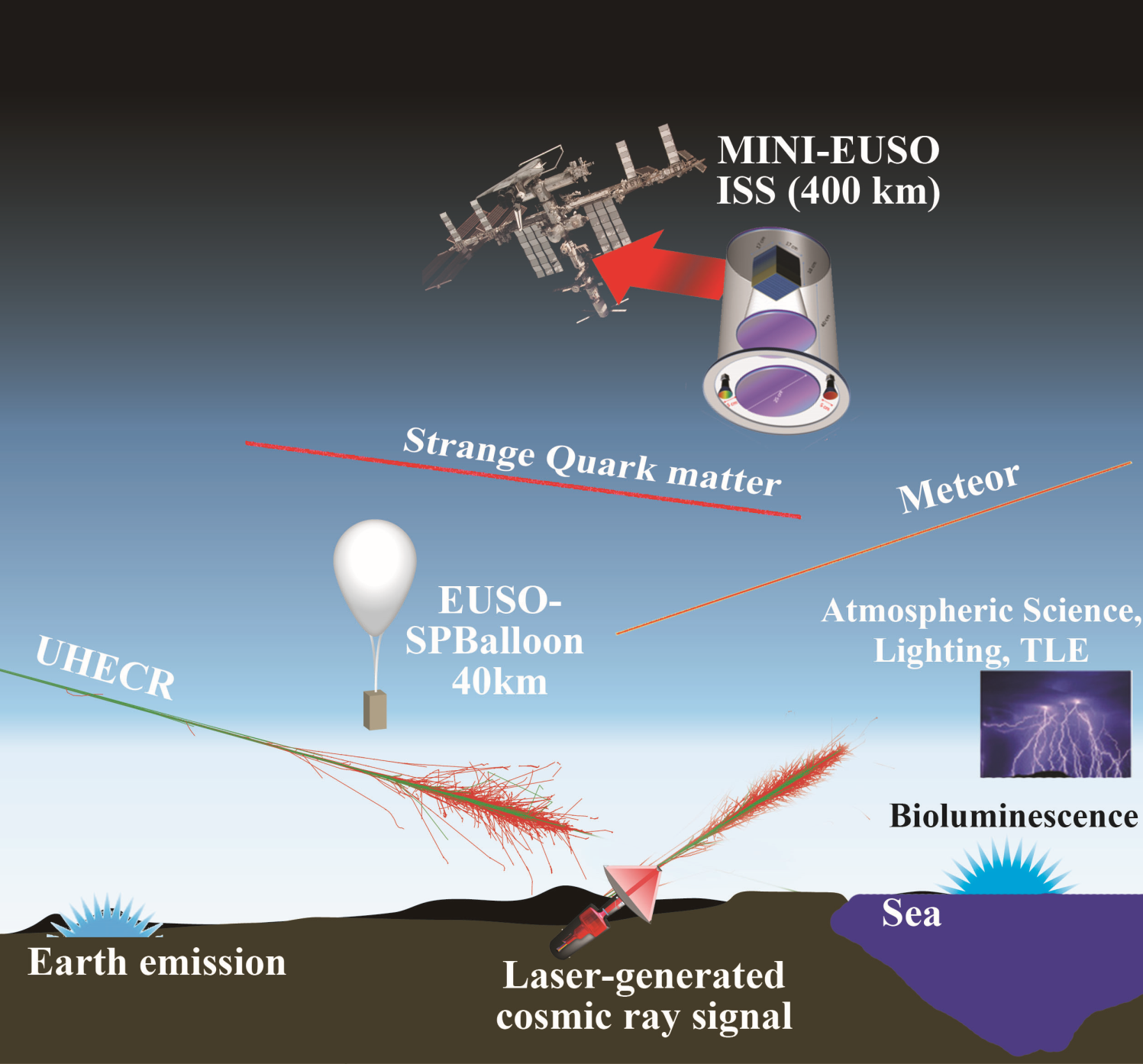
Mini-EUSO now in space
On August 27th Mini-EUSO has been launched from the Baikonur cosmodrome and docked to ISS on August 27.
Mini-EUSO is part of the JEM-EUSO program. JEM-EUSO is a new type of observatory to be attached at the International Space Station or orbiting as a free flyer, based on a UV very large telescope, which uses the whole Earth as detector. It will observe, from an altitude of several hundreds of km, the fluorescence tracks produced at (330-400) nm by Extensive Air Showers (EAS) originated by UHE primaries which traverse the Earth’s atmosphere at ultra-relativistic speed.
Mini-EUSO (Multiwavelength Imaging) is a next-generation telescope for the study and monitoring of terrestrial, atmospheric and cosmic emissions in Ultraviolet (UV). The instrument (37 * 37 * 62 cm3), is an ultra-fast video camera (400 thousand frames per second, 2.5 microsecond/frame), capable of single photon detection on each of the 2304 pixels of the focal surface. The optics is based on Fresnel lenses with 25 cm diameter. The thin and compact construction of the lenses is particularly suitable for space-borne detectors. The field of view on the ground is 40 degrees, corresponding to 260 * 260 km2 on the surface of our planet. With the continuous acquisition of data we can therefore – for the first time – create a dynamic map of nocturnal emissions of ultraviolet in the earth. These measurements are completed by a near infrared and a visible camera.
Mini-EUSO will carry out the first ever night time observations of Earth’s atmosphere from space in the near-ultraviolet band from the UV transparent window in the Zvezda Russian module in the ISS, looking at Earth in a nadir position.
Scientific objectives include:
- Realization of the first UV night map of the Earth with a resolution of a few km.
- Detection and study of meteorites.
- Search for quark strange matter. This hypothetical new state of matter could exist in quarks stars or at the center of neutron stars and reach the Earth in the form of interstellar meteorites. Due to their high density, these fragments of nuclear strange matter would appear as interstellar (220km/s) meteorites that burn for a long time in the atmosphere and with spectral emissions different from the classical meteorites.
- Monitoring and tracking of space debris for the realization of future laser-based removal methods. This is part of a collaboration with Ecole Politecnique (Prof. Morou) to develop a road for debris mitigation using a CAN (Coherent amplification network) laser coupled with a EUSO-like detector to ablate debris in space
- Search for Ultra-high-energy cosmic rays. Detection of artificial showers generated from the ground with UV laser (collaboration with USA/U Chicago and Colorado school of mines)
- Study of marine bioluminescence and of the ‘milky sea’ phenomenon, generated by plankton.
Technological goals include:
- First use of a refractive telescope based on Fresnel lenses in space
- First use of a high sensitivity focal surface, capable of detecting a single photon, and related electronics resistant to the space environment
This type of technologies have applications ranging from the creation of new and larger spatial telescopes such as EUSO, for the study of fundamental physics phenomena in space to practical applications related to the new type of optics and detectors in space (solar energy concentrators, removal of space debris, monitoring of land and pollution …)
The apparatus is made by an international collaboration of 16 nations, in the framework of an agreement between the Italian and Russian space agencies.
Among the contributions we mention (in random order): Japan/Riken Lens and Photomultipliers; France/APC: Integration of focal surface, front-end electronic (with Omega team of Ecole Politechnique), Italy/INFN-University of Rome Tor Vergata: CPU, mechanics, ancillary detectors, integration and qualification, Sweden/KTH: acquisition software, Lodz University /Poland: High Voltage power supply.
In Italy the University of Rome Tor Vergata and the National Institute of Nuclear Physics coordinate the work of a team involving the Universities of Bari, Catania, Naples, Turin, the Uninettuno Telematic University and INAF.
M. Casolino, INFN / Università di Roma Tor Vergata / RIKEN
Further information:
- Photos and video of the launch: http://jem-euso.roma2.infn.it/?page_id=43683
- Demonstration designs for the remediation of space debris from the International Space Station: https://doi.org/10.1016/j.actaastro.2015.03.004
- Mini-EUSO: A high resolution detector for the study of terrestrial and cosmic UV emission from the International Space Station: https://doi.org/10.1016/j.asr.2017.08.030
- JEM-EUSO experiement: http://jem-euso.roma2.infn.it/






